GlobalSim has long been known as a premier manufacturer of crane simulators throughout the world. One distinctive feature that is found in most of our crane simulator systems is a motion base. “To create a truly immersive training experience, the simulator should replicate the motion that an operator feels in the real equipment.” Says Brad Ball, GlobalSim’s Vice President of Sales and Marketing.
“There are a variety of different motion bases available in the market, manufactured by a number of different companies”, says Ball. “Most of the time the electrical actuators are located under the operators seat and the operator will feel the chair move (or jerk) while practicing on the simulator. At GlobalSim, we prefer a different approach by building a motion base for the entire cabin.” Ball refers to GlobalSim’s proprietary motion base used on the Full Mission simulators where the motion actuators are located under the entire simulator, not just the operators’ chair. “The realism on a full mission system is much more life-like when the entire simulator moves just as the crane cabin would in real life.”
When it comes to motion in a simulator one must consider Degrees of Freedom (DOF). There are 6 Degrees of freedom (which refers to the freedom of movement of a rigid body in three dimensional space). Specifically these are Surge, Sway, Heave, Pitch, Yaw, and Roll. Typically a crane operator will feel a variety of these movements, depending upon the equipment (or crane model) they are operating. While GlobalSim builds some high-end 6 DOF motion systems, many of the systems (particularly for port cranes and military cranes) only feature a 3 DOF system that incorporates the exact type of motion the operator feels as they operate the crane.
For example, when a Ship-to-Shore crane moves sideways along the quay, the motion system induces “sway”. Then as the cabin moves forward, the student operator will feel the “surge”. Finally, when a container is picked up, the operator will feel the cabin “pitch”. It is important that a trainee practice on a simulator that induces these proper motion cues. If a trainee were to feel insufficient movement or motion in the wrong axis, this may provide negative training value because the student’s eye conflicts with what they feel. “That’s why we prefer a full motion cabin,” says Ball. “Motion is an extremely important element in training. The seat based motion systems just can’t compare to an enclosed cabin with a proper full motion system. The feel is so much more accurate and it provides for a more immersive experience for the student operator.”
